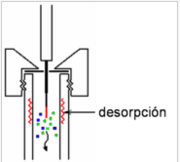Category:SPME
From LEAP
Solid phase microextraction, or SPME, is a sample preparation technique used both in the laboratory and on-site. Developed in the early 1990s at the University of Waterloo by Dr. Pawliszyn's group, it is a simple and inexpensive technique where the use of solvents is not necessary.
SPME can be thought of as a very short gas chromatography column turned inside out. SPME involves the use of a fiber coated with an extracting phase, that can be a liquid polymer or a solid sorbent, which extracts different kinds of analytes (including both volatile and non-volatile) from different kinds of media, that can be in liquid or gas phase. The quantity of analyte extracted by the fiber is proportional to its concentration in the sample so long as Chemical equilibrium is reached or, in case of short time pre-equilibrium, with help of convection or agitation. After extraction, the SPME fiber is transferred to the injection port of separating instruments, such as a Gas-liquid chromatography, where desorption of the analyte takes place and analysis is carried out.
The attraction of SPME is that the extraction is fast and simple and can be done without solvents, and detection limits can reach parts per trillion (ppt) levels for certain compounds. SPME also has great potential for field applications; on-site sampling can be done even by non scientists without the need to have a GC-MS at each location. When properly stored, samples can be analyzed days later in the laboratory without significant loss of volatiles.
SPME is an equilibrium process based upon Fick’s 1st law of diffusion
SPME is a technique where the sample is incubated or agitated to equilibrate the headspace. A SPME fiber is then introduced to the headspace for a predetermined period of time. The SPME fiber is then transferred to a hot GC injection port. Analytes that were adsorbed to the fiber from the sample headspace are desorbed directly in the GC inlet. SPME fibers are a distributed by Supleco and are available in a wide variety of polarities. By matching fiber polarity with target analyte characteristics, the analysis can be optimized for improved sensitivity and performance.
![]() Supelco /Sigma Aldrich SPME Website and information
Supelco /Sigma Aldrich SPME Website and information
Contact LEAP
For additional information about this technique please contact LEAP Technologies for detailed information
Pages in category "SPME"
The following 5 pages are in this category, out of 5 total.


